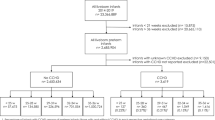Abstract
Objective
To evaluate the optimal timing of neonates with prenatally diagnosed congenital diaphragmatic hernia (CDH).
Methods
Data from a retrospective cohort study conducted by the Japanese CDH Study Group between 2011 and 2018 were divided into two groups according to delivery timing: 36–37 and 38–41 weeks of gestation (wg). Death before 90 days as the primary outcome and the duration of hospitalization, oxygen therapy and tube feeding at discharge as the secondary outcomes were analyzed with generalized linear model applying inverse probability of treatment weighting method. We also performed layered analysis according to stomach position.
Result
Among 493 neonates with prenatally diagnosed, isolated and left CDH, 237 were born at 38–41wg. The duration of hospitalization was significantly shorter in those born at 38–41wg, especially among those with stomach malposition, and the other outcomes showed no difference.
Conclusions
Delivery at 38–41wg could be beneficial for those with high grade stomach position.

Similar content being viewed by others
References
Langham MR, Kays DW, Ledbetter DJ, Frentzen B, Sanford LL, Richards DS. Congenital diaphragmatic hernia: epidemiology and outcome. Clin Perinatol. 1996;23:671–88.
Paoletti M, Raffler G, Gaffi MS, Antounians L, Lauriti G, Zani A prevalence and risk factors for congenital diaphragmatic hernia: a global view. J Pediatr Surg. 2020.
Balayla J, Abenhaim HA. Incidence, predictors and outcomes of congenital diaphragmatic hernia: a population-based study of 32 million births in the United States. J Matern Fetal Neonat Med. 2014;27:1438–44.
Kitano Y, Okuyama H, Saito M, Usui N, Morikawa N, Masumoto K, et al. Re-evaluation of stomach position as a simple prognostic factor in fetal left congenital diaphragmatic hernia: a multicenter survey in Japan. Ultrasound Obstet Gynecol. 2011;37:277–82.
Stevens TP, van Wijngaarden E, Ackerman KG, Lally PA, Lally KP, Congenital Diaphragmatic Hernia Study Group. Timing of delivery and survival rates for infants with prenatal diagnoses of congenital diaphragmatic hernia. Pediatrics. 2009;123:494–502.
Hutcheon JA, Butler B, Lisonkova S, Marquette GP, Mayer C, Skoll A, et al. Timing of delivery for pregnancies with congenital diaphragmatic hernia. Br J Obstet Gynaecol. 2010;117:168–162.
Odibo AO, Najaf T, Vachharajani A, Warner B, Mathur A, Warner BW. Predictors of the need for extracorporeal membrane oxygenation and survival in congenital diaphragmatic hernia: a center’s 10-year experience. Prenat Diagn. 2010;30:518–21.
Safavi A, Lin Y, Skarsgard ED. Canadian Pediatric Surgery Network. Perinatal management of congenital diaphragmatic hernia: when and how should babies be delivered? Results from the Canadian Pediatric Surgery Network. J Pediatr Surg. 2010;45:2334–9.
Snoek KG, Reiss IKM, Greenough A, Capolupo I, Urlesberger B, Wessel L, et al. Standardized postnatal management of infants with congenital diaphragmatic hernia in Europe: the CDH EURO Consortium Consensus −2015 update. Neonatology. 2016;110:66–74.
Burgos CM, Frenckner B, Luco M, Harting MT, Lally PA, Lally KP. Prenatally diagnosed congenital diaphragmatic hernia: optimal mode of delivery? J Perinatol. 2017;37:134–8.
Zamora IJ, Olutoye OO, Cass DL, Fallon SC, Lazar DA, Cassady CI, et al. Prenatal MRI fetal lung volumes and percent liver herniation predict pulmonary morbidity in congenital diaphragmatic hernia (CDH). J Pediatr Surg. 2014;49:688–93.
Acknowledgements
We thank all institutions that collected the data used for the present study.
Funding
The Health and Labor Sciences Research Grants for Research on Intractable Diseases from the Ministry of Health, Labor and Welfare of Japan.
Author information
Authors and Affiliations
Contributions
YK mainly contributed to the design of the work, data analysis and interpretation of the work and drafting. EM contributed to the design of the work and interpretation of data for work. MF and TM supervised the analysis. NU, KN, KT, MH, SA, KM, TO, NI, NU, KT, KU, TF, MO, AY, and TT contributed to data collection, making revisions for the draft and interpretation of the work. HO contributed to data collection, supported the study design, revised the draft, and approved the final version to be published.
Corresponding author
Ethics declarations
Conflict of interest
The authors declare no competing interests.
Additional information
Publisher’s note Springer Nature remains neutral with regard to jurisdictional claims in published maps and institutional affiliations.
Supplementary information
Rights and permissions
About this article
Cite this article
Kawanishi, Y., Endo, M., Fujii, M. et al. Optimal timing of delivery for pregnancies with prenatally diagnosed congenital diaphragmatic hernia: a propensity-score analysis using the inverse probability of treatment weighting. J Perinatol 41, 1893–1900 (2021). https://doi.org/10.1038/s41372-021-01118-2
Received:
Revised:
Accepted:
Published:
Issue Date:
DOI: https://doi.org/10.1038/s41372-021-01118-2
- Springer Nature America, Inc.
This article is cited by
-
Preoperative Management of Congenital Diaphragmatic Hernia
Current Treatment Options in Pediatrics (2022)




